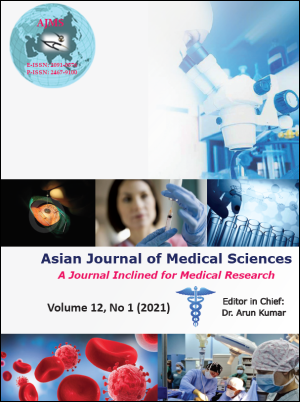Can calculated SdLDL serve as a substitute for estimated SdLDL?
Keywords:
Calculated SdLDL, Measured SdLDL, Non HDL, Lipid profile, TG HDL ratioAbstract
Background: SdLDL is the atherogenic component of LDL. Though it is a predictive biomarker for coronary artery disease, lack of standardisation, complexity and cost of analytical techniques has prevented SdLDL from being routinely estimated in clinical practice. Methods available for estimation include Ultracentrifugation, NMR, HPLC and the enzymatic method. Srisawasdi et al. 2011 developed a formula for estimation of SdLDL
using commonly estimated lipid parameters. The formula was: SdLDL (mg/dl) = 0.580(non HDL- Cholesterol) + 0.407(direct LDL- Cholesterol) – 0.719(calculated LDL- Cholesterol) – 12.05. Mohan et al. 2005 proposed that Triglyceride/ HDL ratio of 3.0 had optimum sensitivity for predicting elevated SdLDL, hence TG/HDL ratio could be used to predict SdLDL levels instead of directly estimating SdLDL.
Aims and Objectives: The study was to determine the correlation between SdLDL estimated using the enzymatic method and between that calculated using Srisawasdi’s formula, and Mohan et al.’s proposed TG/HDL ratio.
Materials and Methods: This a retrospective study done on 374 samples for which total cholesterol, HDL, LDL and triglycerides were estimated using routine methods and SdLDL by the enzymatic method. SdLDL was calculated using Srisawasdi’s formula and correlation was determined between estimated and calculated SdLDL. We also determined the correlation between the estimated SdLDL and TG/HDL ratio, and with Non HDL.
Results: A highly significant and positive correlation was found between estimated and calculated SdLDL (r=0.74, p<0.001), and between estimated SdLDL and non HDL (r=0.721, p=<0.001). The correlation between SdLDL and TG/HDL ratio was positive but poor (r=0.353).
Conclusions: Calculated SdLDL may be used as a substitute for estimated SdLDL. Further studies on a larger population are required before use of calculated SdLDL can be implemented in routine clinical practice.
Downloads
Downloads
Published
How to Cite
Issue
Section
License
Authors who publish with this journal agree to the following terms:
- The journal holds copyright and publishes the work under a Creative Commons CC-BY-NC license that permits use, distribution and reprduction in any medium, provided the original work is properly cited and is not used for commercial purposes. The journal should be recognised as the original publisher of this work.
- Authors are able to enter into separate, additional contractual arrangements for the non-exclusive distribution of the journal's published version of the work (e.g., post it to an institutional repository or publish it in a book), with an acknowledgement of its initial publication in this journal.
- Authors are permitted and encouraged to post their work online (e.g., in institutional repositories or on their website) prior to and during the submission process, as it can lead to productive exchanges, as well as earlier and greater citation of published work (See The Effect of Open Access).




